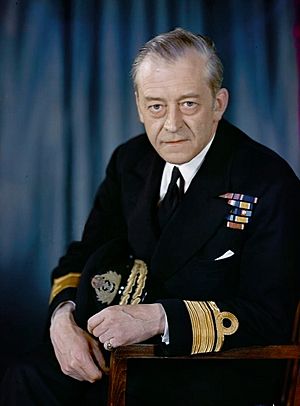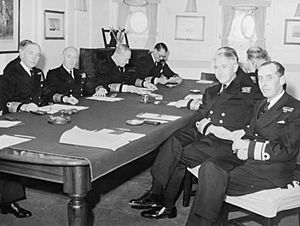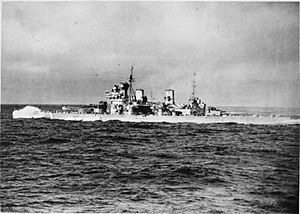George Creasy facts for kids
Quick facts for kids
Sir George Creasy
|
|
|---|---|

Sir George Creasy
|
|
| Born | 13 October 1895 Badulla, Sri Lanka |
| Died | 31 October 1972 (aged 77) Great Horkesley, Essex, England |
| Buried |
St. Peter and St. Paul's Churchyard, Little Horkesley
|
| Allegiance | United Kingdom |
| Service/ |
Royal Navy |
| Years of service | 1908–1957 |
| Rank | Admiral of the Fleet |
| Commands held | Portsmouth Command (1954–57) Home Fleet (1952–54) Flag Officer Submarines (1944–46) HMS Duke of York (1942–44) HMS Codrington (1940) HMS Grenville (1938–40) |
| Battles/wars | First World War Second World War |
| Awards | Knight Grand Cross of the Order of the Bath Commander of the Order of the British Empire Distinguished Service Order Member of the Royal Victorian Order Commander of the Order of Orange-Nassau (Netherlands) Commander's Cross of the Order of Polonia Restituta (Poland) Commander of the Legion of Merit (United States) |
Admiral of the Fleet Sir George Elvey Creasy (born October 13, 1895 – died October 31, 1972) was a very important officer in the Royal Navy. He reached the highest rank in the British Navy, Admiral of the Fleet.
Sir George Creasy served in both the First World War and the Second World War. During his career, he commanded several ships and held many key leadership roles. He was known for his bravery and skill, especially during the Second World War. He helped rescue important people and played a big part in major naval operations.
Contents
Starting His Journey
George Creasy was born in Badulla, Sri Lanka. His father was Leonard Creasy. George went to special naval schools in England, including the Royal Naval College, Osborne and the Royal Naval College, Dartmouth.
He joined the Royal Navy in September 1908 as a cadet. This was the start of his long and successful career at sea. By May 1913, he became a midshipman on the battleship HMS Conqueror.
Service in the First World War
During the First World War, George Creasy served on HMS Conqueror. Later, he moved to smaller, faster ships called torpedo-boat destroyers. He was promoted to sub-lieutenant in November 1915 and then to lieutenant in May 1917.
As a lieutenant, he was the first lieutenant on the destroyer HMS Nonsuch. He took part in naval operations at Heligoland Bight in 1917. After the war, he trained to become a torpedo officer, learning all about torpedoes and how to use them.
Between the World Wars
After the First World War, Creasy continued to serve in the Royal Navy. He became a torpedo officer on several ships, including the destroyer HMS Malcolm. He also taught at the torpedo school, HMS Vernon.
He was promoted to lieutenant-commander in December 1924. He served on important battleships like HMS Warspite and HMS Rodney. In June 1930, he became a commander.
Later, he worked in planning roles at the Admiralty, which was the main office for the Royal Navy. By December 1935, he was promoted to captain. He then commanded the 1st Destroyer Flotilla in the Mediterranean Fleet and his own ship, HMS Grenville.
Heroic Actions in the Second World War
Sir George Creasy played a vital role in the Second World War. He first commanded HMS Grenville, which was unfortunately sunk in January 1940. He then took command of the destroyer HMS Codrington.
Dunkirk and Royal Rescue
On HMS Codrington, he led the rescue of Juliana of the Netherlands, who was the Crown Princess of the Netherlands, in May 1940. Soon after, he took part in the famous Dunkirk evacuation. This was when many Allied soldiers were rescued from the beaches of France. For his great skill and leadership during these events, he received the Distinguished Service Order.
Key Roles and Normandy Landings
Creasy continued to take on important jobs. He became the chief staff officer to the First Sea Lord, who was the professional head of the Royal Navy. He also directed anti-submarine warfare, helping to protect ships from enemy submarines.
In September 1942, he became the flag captain on the battleship HMS Duke of York. This ship was the flagship of the Home Fleet. He was promoted to rear admiral in July 1943.
One of his most important roles was helping to plan and carry out the naval operations for the Normandy landings in June 1944. This huge operation, called Operation Neptune, was a key part of the D-Day invasion. After the war, he was in charge of receiving surrendered enemy submarines in British ports.

Post-War Leadership
After the Second World War, Sir George Creasy continued to rise through the ranks. He became Flag Officer (Air) for the Far East Fleet in February 1947. This meant he was in charge of naval air operations in that region.
He was promoted to vice-admiral in January 1948. He then became the Fifth Sea Lord and deputy chief of the Naval Staff (Air). This role involved leading the naval air arm.
In November 1949, he became Vice Chief of the Naval Staff. This was a very senior position, helping to lead the entire Royal Navy. He was promoted to full admiral in January 1951.
From January 1952, he commanded the Home Fleet and also the Eastern Atlantic Area for NATO. He sailed on important ships like the aircraft carrier HMS Indomitable and the battleship HMS Vanguard.
Finally, in September 1954, he became Commander-in-Chief, Portsmouth. This was a major command in the UK. He was promoted to Admiral of the Fleet in April 1955, the highest rank, before retiring in 1957.
In 1924, George Creasy married Monica Frances Ullathorne. They had a daughter and a son.
After retiring from the Royal Navy, Sir George Creasy became a Deputy Lieutenant of Essex. He also served as the president of the Essex branch of the Royal British Legion, an organization that supports veterans. He enjoyed fishing and shooting.
Sir George Creasy passed away at his home in Great Horkesley, Essex, on October 31, 1972. He was buried in the churchyard of St. Peter and St. Paul's Church in Little Horkesley.


